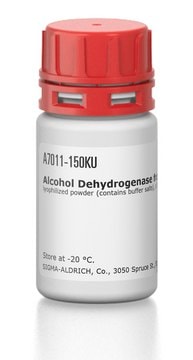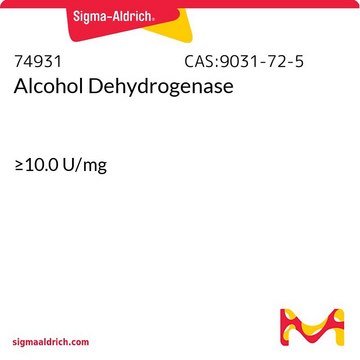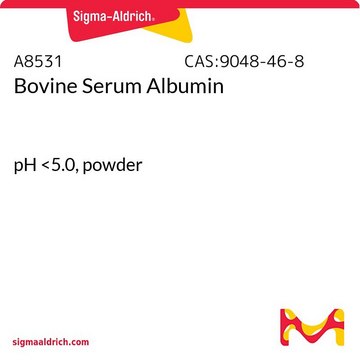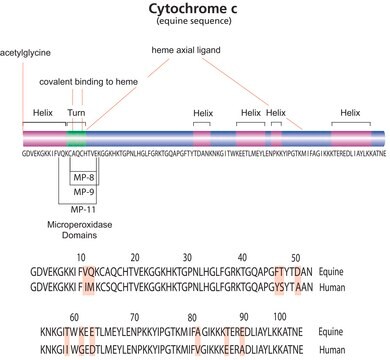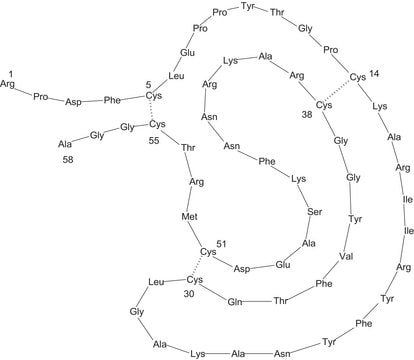A8656
Alcohol Dehydrogenase from Saccharomyces cerevisiae
Synonym(s):
ADH, Alcohol Dehydrogenase from yeast, Alcohol:NAD+ oxidoreductase
Sign Into View Organizational & Contract Pricing
All Photos(1)
About This Item
Recommended Products
biological source
Saccharomyces cerevisiae
Quality Level
form
powder
mol wt
~150,000
packaging
vial of 25 mg
storage temp.
−20°C
Looking for similar products? Visit Product Comparison Guide
Application
Alcohol Dehydrogenase from Saccharomyces cerevisiae has been used as a gel filtration molecular weight marker/ It has also been used as a component of nine protein mixture for mass spectroscopy analysis.
Biochem/physiol Actions
ADH (alcohol dehydrogenase) is one of the first enzymes to be isolated and purified. NAD+ is its coenzyme. Three isozymes of yeast ADH, that is, yeast alcohol dehydrogenase-1, 2 and 3 (YADH-1, -2, -3) have been identified. YADH-1 is expressed during anaerobic fermentation, YADH-2 is expressed in the cytoplasm and YADH-3 is localized to the mitochondria. A 141kDa tetramer containing 4 equal subunits. The active site of each subunit contains a zinc atom. Each active site also contains 2 reactive sulfhydryl groups and a histidine residue.
Isoelectric point: 5.4-5.8
Optimal pH: 8.6-9.0
Substrates: Yeast ADH is most active with ethanol and its activity decreases as the size of the alcohol increases or decreases. Branched chain alcohols and secondary alcohols also have very low activity.
KM (ethanol) = 2.1 × 10-2 M
KM (methanol = 1.3 × 10-1 M
KM (isopropanol) = 1.4 × 10-1 M
Inhibitors: Compounds that react with free sulfhydryls, including N-alkylmaleimides and iodoacetamide.
Zinc chelator inhibitors, including 1,10-phenanthroline,
8-hydroxyquinoline, 2,2′-dipyridyl, and thiourea.
Substrate analogue inhibitors, including β-NAD analogs, purine and pyrimidine derivatives, chloroethanol, and fluoroethanol.
Extinction Coefficient: E1% = 14.6 (water, 280 nm)
Isoelectric point: 5.4-5.8
Optimal pH: 8.6-9.0
Substrates: Yeast ADH is most active with ethanol and its activity decreases as the size of the alcohol increases or decreases. Branched chain alcohols and secondary alcohols also have very low activity.
KM (ethanol) = 2.1 × 10-2 M
KM (methanol = 1.3 × 10-1 M
KM (isopropanol) = 1.4 × 10-1 M
Inhibitors: Compounds that react with free sulfhydryls, including N-alkylmaleimides and iodoacetamide.
Zinc chelator inhibitors, including 1,10-phenanthroline,
8-hydroxyquinoline, 2,2′-dipyridyl, and thiourea.
Substrate analogue inhibitors, including β-NAD analogs, purine and pyrimidine derivatives, chloroethanol, and fluoroethanol.
Extinction Coefficient: E1% = 14.6 (water, 280 nm)
Alcohol Dehydrogenase (ADH) is an oxidoreductase and also a pyridine nucleotide-dependent dehydrogenase. It catalyzes the generation of aldehydes or ketones by reversible oxidation of alcohols. ADH in parallel also mediates the reduction of the nicotinamide adenine dinucleotide (NAD+) or nicotinamide adenine dinucleotide phosphate (NADP+). ADH from yeast is more active than mammalian ADHs.
Signal Word
Danger
Hazard Statements
Precautionary Statements
Hazard Classifications
Resp. Sens. 1
Storage Class Code
11 - Combustible Solids
WGK
WGK 1
Flash Point(F)
Not applicable
Flash Point(C)
Not applicable
Personal Protective Equipment
dust mask type N95 (US), Eyeshields, Gloves
Certificates of Analysis (COA)
Search for Certificates of Analysis (COA) by entering the products Lot/Batch Number. Lot and Batch Numbers can be found on a product’s label following the words ‘Lot’ or ‘Batch’.
Already Own This Product?
Find documentation for the products that you have recently purchased in the Document Library.
Customers Also Viewed
Yeast alcohol dehydrogenase structure and catalysis
Raj S, et al.
Biochemistry, 53(36), 5791-5803 (2014)
Determination of hydrodynamic radius of proteins by size exclusion chromatography
La Verde V, et al.
Bio-protocol, 7(8), 1-14 (2017)
Application of de novo sequencing to large-scale complex proteomics data sets
Devabhaktuni A and Elias JE
Journal of Proteome Research, 15(3), 732-742 (2016)
Study of Reduction Properties of Enzyme Alcohol Dehydrogenase from Saccharomyces cerevisiae Meyen ex. Hansen on Some Selected Compounds
Khan SYN
International journal of language & communication disorders, 3(4), 1218-1222 (2017)
Jung-Eun Kim et al.
Frontiers in immunology, 11, 593748-593748 (2021-01-26)
Patients with severe eosinophilic asthma (SEA; characterized by persistent eosinophilia in blood and airway tissues) experience frequent asthma exacerbations with poor clinical outcomes. Interleukin 5 (IL-5) and IL-5 receptor alpha subunit (IL-5α) play key roles in eosinophilia maintenance, and relevant
Our team of scientists has experience in all areas of research including Life Science, Material Science, Chemical Synthesis, Chromatography, Analytical and many others.
Contact Technical Service